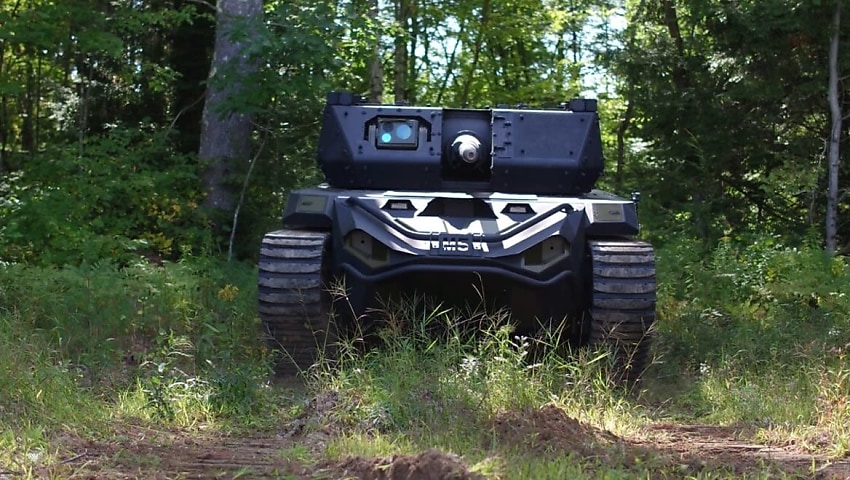Much has been made of the thrust towards automatisation in recent years – but, until recently, it’s been largely limited to the civilian space. Over the weekend, the Robotic Combat Vehicle Soldier Operational Experiment came to a close in Fort Carson, Colorado – and the results have outpaced the service’s expectations.
To continue reading the rest of this article, please log in.
Create free account to get unlimited news articles and more!
Over the course of the week to come, US Army modernisation officials will round off the service's first experiment with Robotic Combat Vehicles (scheduled to end 14 August).
While plans have been in the works since late last year – with successive rounds whittling the field down to just a few bids back in January – Army’s Combat Capabilities Development Command and Next Generation Combat Vehicle Cross-Functional Team has given short shrift to all else bar:
- QinetiQ North America and partner Pratt & Miller: which plan to provide four of their seven-ton EMAV robots (Expeditionary Modular Autonomous Vehicles) to serve as the RCV-Light; and
- Textron: which plans to provide four of its 10-plus-ton Ripsaw mini-tanks to serve as the RCV-Medium (Textron also offered a stripped-down Ripsaw variant for RCV-Light).
The multi-test phase hopes to upgrade today's generation of RCVs from the "geriatric" M113 troop carrier to a family of purpose-built family of RCVs. As the selection process shows, as well, the service plans on introducing unmanned RCVs that cover a broad range of roles, from smaller scouts through to "mini-tanks".
The test
Over the course of the past five weeks, 4th Infantry Division soldiers based at Fort Carson have been carrying out cavalry-style combat missions in modified Bradley fighting vehicles to direct robotic surrogate M113s. Though Textron has been sidelined for the moment (its prototype is still being improved and refined), the success seen by the QinetiQ team is likely to pile pressure to perform on the latter.
So, what troubles, if any, have the testers encountered? For one, autonomous vehicles have difficulty interpreting the natural environment.
“Right now, it’s very difficult for a robot that looks at a puddle. It doesn’t know if it’s a Marianas Trench, or if it’s two inches deep,” said Major Cory Wallace, the Army's Robotic Combat Vehicle Lead. “It’s something that we as human beings can contextualise, but the robot has a hard time doing it.”
While this might run counter to much of what you've heard in recent years about the state of autonomous vehicles in the private sector, it's well worth remembering that those are designed to drive on standardised roads. Army vehicles, on the other hand, are required to traverse rough and inhospitable terrain where problems such as these are likely to be more significant in scope – exactly the reason the trials are being carried out in the hilly terrain south of Colorado Springs.
The testers also took issue with target recognition technology, which seeks to link the robotic vehicle with the control platform.
"It works while stationary, but part of the challenge is how do you do that on the move and how that is passed to the gunner," said Brigadier General Richard "Ross" Coffman, director of the Army's Next Generation Combat Vehicle-Cross Functional Team.
"We've got some challenges to get the control vehicle and the robot vehicle to communicate adequately beyond 1,000 metres.
"The distance between the robot and the controller is a physics problem and, when you talk flat earth, you can go over a kilometre from the controller to the robot."
The best
"This experiment was 100 per cent successful ... because we learned; the whole purpose was to learn where the technology is now and how we think we want to fight with it in the future," said BG Coffman.
"All of the technology was not successful; it's a sliding scale. Some knocked our socks off, and some -- we've got a little bit of work to do."
One of the areas BG Coffman points to as a win was the communications system – which worked much better than planners have initially expected.
"The interface with the crew ... so the soldiers see where they are, they see where the robots are, they can communicate graphics ... it just absolutely blew us away," he said.
"The software between the robotic vehicle and the control vehicle – while not perfect – performed better than we thought it would."
The rest
The service plans to build on the wins (and losses) seen at Fort Carson with a battery of subsequent wet runs; the first of which is scheduled for Fort Hood, in Texas' arid centre. Though this won't take place til 2022, the interim will take both parties back to the drawing board to hash out communications, infrared, and navigational issues.
"Is the technology where we thought it would be, should we continue to spend money on this effort or should we cease effort?" BG Coffman said. That's what he plans to ask, at least, after the conclusion of both runs – building towards a final 2023 decision on whether the program will become a formal program of record.
Nevertheless, the benefits of being able to engage actors remotely, without the need for boots on the ground, have been manifest over successive Gulf deployments (and other counterinsurgency operations carried out since Vietnam). It's a politically appealing way of conducting warfare – and what's more, it might even have operational appeal too.
Your thoughts
Does the Fort Carson test show that autonomous strategy is the way forward – either for the US or Australia? Or is this one aree where a human touch will always be required? Let us know in the comments section below, or get in touch at

 Login
Login







